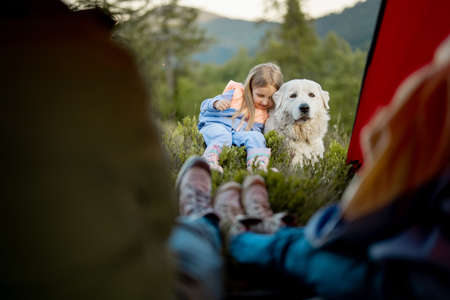Skipping Essential Prep
Camping with pets and children is a rewarding adventure, but it all starts with thoughtful preparation. Forgetting to plan ahead is one of the most common mistakes families make. Before you head out, create a checklist that covers not just the basics—like tents and food—but also gear specific to your kids and pets. Think about comfort items, first aid supplies, extra water, and their favorite snacks or toys. Remember, unfamiliar environments can be stressful for both little ones and animals. Planning for their safety means packing leashes, harnesses, child-safe bug spray, sun protection, and knowing where the nearest vet or urgent care is located. A little prep goes a long way toward keeping everyone happy and safe around the campfire.
2. Ignoring Local Wildlife
When camping with pets and children, overlooking the presence of local wildlife is a common but serious mistake. Understanding the dangers specific to your campsite—whether it’s snakes in the Southwest, bears in the Rockies, or raccoons near lakes—keeps everyone safer. Respecting animal habitats means teaching kids not to disturb nests or burrows and ensuring pets are leashed and supervised at all times.
Safe Food Storage Matters
Improper food storage can attract unwanted animals. Use bear-proof containers or hang food out of reach when necessary. Remind children never to feed wildlife, no matter how cute they seem.
Quick Guide: Wildlife Safety Essentials
| Do | Don’t |
|---|---|
| Store food securely | Leave snacks unattended |
| Keep pets leashed | Let pets roam free |
| Teach kids about local animals | Allow children to chase wildlife |
Respect for Nature = Safer Adventures
By understanding local wildlife and following simple precautions, you help ensure a harmonious camping experience for both your family and the environment.

3. Neglecting Campsite Rules
Respecting campsite rules is essential when camping with pets and children. These guidelines are designed to protect everyone’s safety, the natural environment, and the experience of fellow campers.
The Importance of Leash Laws
Many campsites require pets to be on a leash at all times. Leash laws aren’t just about controlling your dog—they prevent unexpected wildlife encounters, reduce stress for other campers, and keep your pet safe from hazards like poison ivy or nearby roads. Even if your dog is well-trained, keeping them leashed shows respect for others sharing the space.
Quiet Hours Matter
Most campgrounds set quiet hours to help everyone enjoy a peaceful night. Kids playing loudly or pets barking after dark can disrupt this tranquility. Remind children about nighttime etiquette and bring comfort items or treats for pets to keep them calm. Observing quiet hours helps foster a considerate camping community.
Leave No Trace Principles
Teaching kids and managing pets according to Leave No Trace principles is crucial for environmental preservation. Pack out all trash, dispose of pet waste properly, and leave what you find—no picking wildflowers or disturbing habitats. Setting this example not only keeps nature pristine but also instills respect for the outdoors in young campers.
Final Thought
Following campsite rules isn’t just about avoiding fines—it’s about harmony with nature and those around you. When you honor these simple guidelines, you help create a welcoming and sustainable camping culture for everyone.
4. Packing the Wrong Food and Supplies
One of the most common slip-ups when camping with pets and kids is not packing the right food and essentials. Kids and animals have unique dietary needs, and forgetting this can lead to cranky moods or even health issues. Choose nutrient-dense, easy-to-prepare meals for children, avoiding anything overly processed or sugary. For pets, bring their usual food—abrupt changes in diet can upset their stomachs. Don’t forget fresh water for everyone; natural sources may not always be safe for drinking.
Tips for Smart Packing
- Pre-pack healthy snacks for kids—think fruit, trail mix, granola bars.
- Pack pet-safe treats and avoid sharing human food that could harm them (like chocolate or grapes).
- Bring collapsible bowls for pets and reusable water bottles for each family member.
- Include extra portions in case of delays or emergencies.
Essentials Checklist
| For Kids | For Pets |
|---|---|
| Healthy snacks Meals ready to heat Reusable utensils Water bottle Comfort items (blanket/stuffed animal) |
Regular pet food Treats Collapsible bowl Leash/harness Paw wipes/towel |
Pro Tip
If your child or pet has allergies, double-check ingredient labels and bring any necessary medications. Advance planning means fewer surprises and a smoother camping experience for all.
5. Underestimating Weather and Terrain
Weather in the wild can shift without warning, especially in the diverse landscapes of America’s national parks and campgrounds. A common mistake is failing to prepare for these changes, which can quickly turn an enjoyable trip into a stressful one—especially with pets and kids along. Dressing everyone in layers is essential. Mornings may be chilly, afternoons warm, and evenings cool again. Quick-dry fabrics and insulated jackets work well for both children and pets. Always pack extra socks, hats, and lightweight rain gear. Don’t forget that dogs might need their own coats or booties if temperatures drop or terrain gets rough.
Rainy weather can bring mud, slippery trails, and damp gear. Store essentials in waterproof bags and teach kids how to keep their sleeping bags dry. Bring towels for muddy paws and wet shoes, and create a cozy spot inside your tent or under a tarp for everyone to unwind. When it comes to terrain, remember that rocky paths or steep hills might not suit all pets or young children. Scout ahead when possible, choose trails that match your group’s abilities, and plan frequent breaks so no one gets overtired or overwhelmed.
Comfort is key to a successful trip. Check campsite conditions before arriving, anticipate temperature swings, and prioritize shelter from wind and rain. These thoughtful steps ensure that every family member—two- or four-legged—feels secure and content in nature.
6. Forgetting First Aid Basics
When you’re out in the wild with kids and pets, accidents can happen in a blink. It’s easy to overlook first aid basics while packing for your camping adventure, but being unprepared can quickly turn a small mishap into a stressful situation. A comprehensive first aid kit is your best friend outdoors—think beyond just bandages and pain relievers. Pack essentials for everyone: children’s medications, allergy relief, antiseptic wipes, tweezers for splinters or ticks, pet-safe wound care supplies, and even an emergency blanket. Make sure your kit includes instructions or a quick guide for common outdoor injuries. Check expiration dates before you leave, and store the kit somewhere easily accessible. Taking these simple steps brings peace of mind and helps everyone—two-legged or four—stay safe so you can focus on enjoying the beauty around you.

